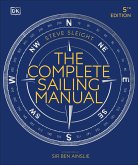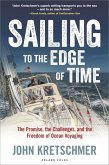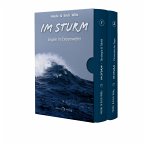Steve Colgate, Doris Colgate
Fast Track to Cruising
How to Go from Novice to Cruise-Ready in Seven Days
29,99 €
inkl. MwSt.
Versandfertig in über 4 Wochen

15 °P sammeln
Steve Colgate, Doris Colgate
Fast Track to Cruising
How to Go from Novice to Cruise-Ready in Seven Days
- Broschiertes Buch
- Merkliste
- Auf die Merkliste
- Bewerten Bewerten
- Teilen
- Produkt teilen
- Produkterinnerung
- Produkterinnerung
From first sail to cruising a mid-sized sailboat, here is a how-to book tailored to would-be sailors with big dreams and little time Like the "Fast Track to Cruising" course, this book starts with the basics of sailing and moves the reader quickly through days ailing to cruising. The first half covers all the steps from learning to sail to live-a-board cruising in outline format, offering synopses of key information along that path. Each key point is cross-linked to a fuller exposition in the second half of the book, helping the reader to a fuller understanding of the concepts behind the techniques.…mehr
Andere Kunden interessierten sich auch für
![Cruising in Seraffyn Cruising in Seraffyn]() Lin PardeyCruising in Seraffyn15,99 €
Lin PardeyCruising in Seraffyn15,99 €![The Complete Sailing Manual The Complete Sailing Manual]() Steve SleightThe Complete Sailing Manual30,99 €
Steve SleightThe Complete Sailing Manual30,99 €![Sailing to the Edge of Time Sailing to the Edge of Time]() John KretschmerSailing to the Edge of Time24,99 €
John KretschmerSailing to the Edge of Time24,99 €![Im Sturm Im Sturm]() Heide WiltsIm Sturm29,80 €
Heide WiltsIm Sturm29,80 €![Turkey Cruising Companion Turkey Cruising Companion]() Emma WatsonTurkey Cruising Companion50,99 €
Emma WatsonTurkey Cruising Companion50,99 €![A Cruising Guide to the Southern Bahamas A Cruising Guide to the Southern Bahamas]() Stephen J PavlidisA Cruising Guide to the Southern Bahamas72,99 €
Stephen J PavlidisA Cruising Guide to the Southern Bahamas72,99 €![A Cruising Guide to the Leeward Islands A Cruising Guide to the Leeward Islands]() Stephen J PavlidisA Cruising Guide to the Leeward Islands70,99 €
Stephen J PavlidisA Cruising Guide to the Leeward Islands70,99 €-
-
-
From first sail to cruising a mid-sized sailboat, here is a how-to book tailored to would-be sailors with big dreams and little time
Like the "Fast Track to Cruising" course, this book starts with the basics of sailing and moves the reader quickly through days ailing to cruising. The first half covers all the steps from learning to sail to live-a-board cruising in outline format, offering synopses of key information along that path.
Each key point is cross-linked to a fuller exposition in the second half of the book, helping the reader to a fuller understanding of the concepts behind the techniques.
Hinweis: Dieser Artikel kann nur an eine deutsche Lieferadresse ausgeliefert werden.
Like the "Fast Track to Cruising" course, this book starts with the basics of sailing and moves the reader quickly through days ailing to cruising. The first half covers all the steps from learning to sail to live-a-board cruising in outline format, offering synopses of key information along that path.
Each key point is cross-linked to a fuller exposition in the second half of the book, helping the reader to a fuller understanding of the concepts behind the techniques.
Hinweis: Dieser Artikel kann nur an eine deutsche Lieferadresse ausgeliefert werden.
Produktdetails
- Produktdetails
- Verlag: International Marine / McGraw-Hill Professional
- Seitenzahl: 256
- Erscheinungstermin: 10. Dezember 2004
- Englisch
- Abmessung: 274mm x 217mm x 22mm
- Gewicht: 708g
- ISBN-13: 9780071406727
- ISBN-10: 0071406727
- Artikelnr.: 13632714
- Herstellerkennzeichnung
- Libri GmbH
- Europaallee 1
- 36244 Bad Hersfeld
- gpsr@libri.de
- Verlag: International Marine / McGraw-Hill Professional
- Seitenzahl: 256
- Erscheinungstermin: 10. Dezember 2004
- Englisch
- Abmessung: 274mm x 217mm x 22mm
- Gewicht: 708g
- ISBN-13: 9780071406727
- ISBN-10: 0071406727
- Artikelnr.: 13632714
- Herstellerkennzeichnung
- Libri GmbH
- Europaallee 1
- 36244 Bad Hersfeld
- gpsr@libri.de
Steve Colgate founded the Offshore Sailing School in 1964. He has participated in two America's Cup trials, seventeen Newport-Bermuda races, seven Fastnet Races, the Pan American Games, the Olympics, and six transatlantic races. The Offshore Sailing School operates from four Florida locations (Captiva Island; Ft. Myers Beach; St. Petersburg; and the Florida Keys) and from Chelsea Piers, New York City; Jersey City, NJ; St. Michaels, MD; and the British Virgin Islands. In 2003, US SAILING awarded the Colgates the Timothea Larr Trophy in recognition of their outstanding leadership and excellence in sailing education.
Acknowledgments
Introduction
Day One: Getting to Know Your Boat
Chapter 1: The Language of Sailing
Important Words to Know
How to Measure a Sailboat
How to Describe a Sailboat
Standing Rigging
Running Rigging
Sails and How to Describe Them
Chapter 2: Start Sailing
Sailing Comfort is All about Preparation
Getting Aboard
Getting Ready to Sail
Getting Underway
Steering
Make Yourself Comfortable
Chapter 3: The Points of Sail
Finding Wind Direction
Your Boat is Always on a Tack
Cycling Through the Points of Sail
Changing Course Downwind
Sailing toward the Wind
When Tacks Don't Go as Planned
Day Two: Building Confidence and Skills
Chapter 4: Wind and Sails: A Powerful Team
Wind Creates Lift
Two Sails are More Efficient than One
The Effect of Heeling
Using Telltales
Wind Flow on a Run
Jib Leads
How Sails are Made
Sail Controls
Reading and Using the Wind
Chapter 5: Balance and Stability
How Weather and Lee Helm Affect Balance
How Sails Affect Balance
How Weight Affects Balance
How the Keel and Hull Shape Affect Stability
How to Control Stability
Determining Speed
Sailing Dinghies
Chapter 6: Handling Heavy Weather and Rescuing Crew
Sailing in Heavy Weather
What to Do in a Squall
Crew Overboard!
Day Three: Going and Coming with Ease
Chapter 7: Mooring, Docking and Anchoring Under Sail
Mooring Pickup without a Motor
How to Anchor Under Sail
How to Dock Under Sail
If You Go Aground
Chapter 8: Right-of-Way Rules and Navigation
How to Determine if You are on a Collision Course
Rules of the Road
Navigation Basics
Day Four: Getting Familiar with Bigger Boats
Chapter 9: Segue to a Cruising Boat
Cruising Lingo
Learning the Systems Aboard
Proper Engine Use
Maneuvering Under Power
Chapter 10: Getting Underway
Before You Leave
Leave the Dock in Style
Setting Sail
Safe and Efficient Winch Use
Tidying Up on Deck
Chapter 11: Basic Maneuvers Under Sail and Power
When and Where to Tack
How to Tack a Cruising Boat
How to Jibe a Cruising Boat
Dousing Sails at Day's End
Day Five: Settling Down for the Night
Chapter 12: Docking and Mooring a Cruising Boat
Approaching a Dock
Picking Up a Mooring
Med-Moor Docking
How to Back in from a Preset Mooring
Shutting Down
Chapter 13: Anchoring Your Cruising Boat
Anchors and their Holding Power
Where to Anchor
Setting Your Anchor
When Two Anchors are Better
Anchoring in Deep Water
Special Circumstances
How to Get Going Again
Day Six: Techniques for Successful Cruising
Chapter 14: Sail Trim for Cruising
How to Steer Comfortably
When Wind Velocity Changes
Why Sail Shape is Important
Mainsail Control and Shape
Proper Genoa Trim
Control in Heavy Air
Chapter 15: Safety and Health Tips for Cruising
How to Avoid Being Seasick
Other Health Conditions You Might Encounter
Equipment Failures Can Cause Accidents
Tips for Going Up a Mast
What to Do if Someone Goes Overboard
What to Do if You Go Aground
What to Do if Steering Fails
A Collision Can Ruin Your Day
Sailing at Night and in Restricted Visibility
Day Seven: Gone Cruising!
Chapter 16: Navigation: Knowing Where You Are and Where You Are Going
Becoming a Navigator
How to Use Charts
Where You Can and Cannot Sail
Understanding Variation and Deviation
What is Dead Reckoning?
How to Avoid Hazards
Other Tips for Navigating
Navigating in Current
Satellite Navigation
Chapter 17: Creature Comforts and Other Tips for Cruising
Your Dinghy
Use of Water Aboard
Cooking Aboard
Marine Toilets
Dealing with Garbage
Safety Below
Tips for Swimming and Fishing
Communicating between Boats
Chapter 18: Cruise Ready!
About Bareboat Chartering
What to Pack for Your Cruise
Customs and Currency Abroad
Cruising Courtesy
Beyond Chartering
Appendix 1: Seven-Day Study Program
Appendix 2: Tips and Checklists
Glossary
Index
Introduction
Day One: Getting to Know Your Boat
Chapter 1: The Language of Sailing
Important Words to Know
How to Measure a Sailboat
How to Describe a Sailboat
Standing Rigging
Running Rigging
Sails and How to Describe Them
Chapter 2: Start Sailing
Sailing Comfort is All about Preparation
Getting Aboard
Getting Ready to Sail
Getting Underway
Steering
Make Yourself Comfortable
Chapter 3: The Points of Sail
Finding Wind Direction
Your Boat is Always on a Tack
Cycling Through the Points of Sail
Changing Course Downwind
Sailing toward the Wind
When Tacks Don't Go as Planned
Day Two: Building Confidence and Skills
Chapter 4: Wind and Sails: A Powerful Team
Wind Creates Lift
Two Sails are More Efficient than One
The Effect of Heeling
Using Telltales
Wind Flow on a Run
Jib Leads
How Sails are Made
Sail Controls
Reading and Using the Wind
Chapter 5: Balance and Stability
How Weather and Lee Helm Affect Balance
How Sails Affect Balance
How Weight Affects Balance
How the Keel and Hull Shape Affect Stability
How to Control Stability
Determining Speed
Sailing Dinghies
Chapter 6: Handling Heavy Weather and Rescuing Crew
Sailing in Heavy Weather
What to Do in a Squall
Crew Overboard!
Day Three: Going and Coming with Ease
Chapter 7: Mooring, Docking and Anchoring Under Sail
Mooring Pickup without a Motor
How to Anchor Under Sail
How to Dock Under Sail
If You Go Aground
Chapter 8: Right-of-Way Rules and Navigation
How to Determine if You are on a Collision Course
Rules of the Road
Navigation Basics
Day Four: Getting Familiar with Bigger Boats
Chapter 9: Segue to a Cruising Boat
Cruising Lingo
Learning the Systems Aboard
Proper Engine Use
Maneuvering Under Power
Chapter 10: Getting Underway
Before You Leave
Leave the Dock in Style
Setting Sail
Safe and Efficient Winch Use
Tidying Up on Deck
Chapter 11: Basic Maneuvers Under Sail and Power
When and Where to Tack
How to Tack a Cruising Boat
How to Jibe a Cruising Boat
Dousing Sails at Day's End
Day Five: Settling Down for the Night
Chapter 12: Docking and Mooring a Cruising Boat
Approaching a Dock
Picking Up a Mooring
Med-Moor Docking
How to Back in from a Preset Mooring
Shutting Down
Chapter 13: Anchoring Your Cruising Boat
Anchors and their Holding Power
Where to Anchor
Setting Your Anchor
When Two Anchors are Better
Anchoring in Deep Water
Special Circumstances
How to Get Going Again
Day Six: Techniques for Successful Cruising
Chapter 14: Sail Trim for Cruising
How to Steer Comfortably
When Wind Velocity Changes
Why Sail Shape is Important
Mainsail Control and Shape
Proper Genoa Trim
Control in Heavy Air
Chapter 15: Safety and Health Tips for Cruising
How to Avoid Being Seasick
Other Health Conditions You Might Encounter
Equipment Failures Can Cause Accidents
Tips for Going Up a Mast
What to Do if Someone Goes Overboard
What to Do if You Go Aground
What to Do if Steering Fails
A Collision Can Ruin Your Day
Sailing at Night and in Restricted Visibility
Day Seven: Gone Cruising!
Chapter 16: Navigation: Knowing Where You Are and Where You Are Going
Becoming a Navigator
How to Use Charts
Where You Can and Cannot Sail
Understanding Variation and Deviation
What is Dead Reckoning?
How to Avoid Hazards
Other Tips for Navigating
Navigating in Current
Satellite Navigation
Chapter 17: Creature Comforts and Other Tips for Cruising
Your Dinghy
Use of Water Aboard
Cooking Aboard
Marine Toilets
Dealing with Garbage
Safety Below
Tips for Swimming and Fishing
Communicating between Boats
Chapter 18: Cruise Ready!
About Bareboat Chartering
What to Pack for Your Cruise
Customs and Currency Abroad
Cruising Courtesy
Beyond Chartering
Appendix 1: Seven-Day Study Program
Appendix 2: Tips and Checklists
Glossary
Index
Acknowledgments
Introduction
Day One: Getting to Know Your Boat
Chapter 1: The Language of Sailing
Important Words to Know
How to Measure a Sailboat
How to Describe a Sailboat
Standing Rigging
Running Rigging
Sails and How to Describe Them
Chapter 2: Start Sailing
Sailing Comfort is All about Preparation
Getting Aboard
Getting Ready to Sail
Getting Underway
Steering
Make Yourself Comfortable
Chapter 3: The Points of Sail
Finding Wind Direction
Your Boat is Always on a Tack
Cycling Through the Points of Sail
Changing Course Downwind
Sailing toward the Wind
When Tacks Don't Go as Planned
Day Two: Building Confidence and Skills
Chapter 4: Wind and Sails: A Powerful Team
Wind Creates Lift
Two Sails are More Efficient than One
The Effect of Heeling
Using Telltales
Wind Flow on a Run
Jib Leads
How Sails are Made
Sail Controls
Reading and Using the Wind
Chapter 5: Balance and Stability
How Weather and Lee Helm Affect Balance
How Sails Affect Balance
How Weight Affects Balance
How the Keel and Hull Shape Affect Stability
How to Control Stability
Determining Speed
Sailing Dinghies
Chapter 6: Handling Heavy Weather and Rescuing Crew
Sailing in Heavy Weather
What to Do in a Squall
Crew Overboard!
Day Three: Going and Coming with Ease
Chapter 7: Mooring, Docking and Anchoring Under Sail
Mooring Pickup without a Motor
How to Anchor Under Sail
How to Dock Under Sail
If You Go Aground
Chapter 8: Right-of-Way Rules and Navigation
How to Determine if You are on a Collision Course
Rules of the Road
Navigation Basics
Day Four: Getting Familiar with Bigger Boats
Chapter 9: Segue to a Cruising Boat
Cruising Lingo
Learning the Systems Aboard
Proper Engine Use
Maneuvering Under Power
Chapter 10: Getting Underway
Before You Leave
Leave the Dock in Style
Setting Sail
Safe and Efficient Winch Use
Tidying Up on Deck
Chapter 11: Basic Maneuvers Under Sail and Power
When and Where to Tack
How to Tack a Cruising Boat
How to Jibe a Cruising Boat
Dousing Sails at Day's End
Day Five: Settling Down for the Night
Chapter 12: Docking and Mooring a Cruising Boat
Approaching a Dock
Picking Up a Mooring
Med-Moor Docking
How to Back in from a Preset Mooring
Shutting Down
Chapter 13: Anchoring Your Cruising Boat
Anchors and their Holding Power
Where to Anchor
Setting Your Anchor
When Two Anchors are Better
Anchoring in Deep Water
Special Circumstances
How to Get Going Again
Day Six: Techniques for Successful Cruising
Chapter 14: Sail Trim for Cruising
How to Steer Comfortably
When Wind Velocity Changes
Why Sail Shape is Important
Mainsail Control and Shape
Proper Genoa Trim
Control in Heavy Air
Chapter 15: Safety and Health Tips for Cruising
How to Avoid Being Seasick
Other Health Conditions You Might Encounter
Equipment Failures Can Cause Accidents
Tips for Going Up a Mast
What to Do if Someone Goes Overboard
What to Do if You Go Aground
What to Do if Steering Fails
A Collision Can Ruin Your Day
Sailing at Night and in Restricted Visibility
Day Seven: Gone Cruising!
Chapter 16: Navigation: Knowing Where You Are and Where You Are Going
Becoming a Navigator
How to Use Charts
Where You Can and Cannot Sail
Understanding Variation and Deviation
What is Dead Reckoning?
How to Avoid Hazards
Other Tips for Navigating
Navigating in Current
Satellite Navigation
Chapter 17: Creature Comforts and Other Tips for Cruising
Your Dinghy
Use of Water Aboard
Cooking Aboard
Marine Toilets
Dealing with Garbage
Safety Below
Tips for Swimming and Fishing
Communicating between Boats
Chapter 18: Cruise Ready!
About Bareboat Chartering
What to Pack for Your Cruise
Customs and Currency Abroad
Cruising Courtesy
Beyond Chartering
Appendix 1: Seven-Day Study Program
Appendix 2: Tips and Checklists
Glossary
Index
Introduction
Day One: Getting to Know Your Boat
Chapter 1: The Language of Sailing
Important Words to Know
How to Measure a Sailboat
How to Describe a Sailboat
Standing Rigging
Running Rigging
Sails and How to Describe Them
Chapter 2: Start Sailing
Sailing Comfort is All about Preparation
Getting Aboard
Getting Ready to Sail
Getting Underway
Steering
Make Yourself Comfortable
Chapter 3: The Points of Sail
Finding Wind Direction
Your Boat is Always on a Tack
Cycling Through the Points of Sail
Changing Course Downwind
Sailing toward the Wind
When Tacks Don't Go as Planned
Day Two: Building Confidence and Skills
Chapter 4: Wind and Sails: A Powerful Team
Wind Creates Lift
Two Sails are More Efficient than One
The Effect of Heeling
Using Telltales
Wind Flow on a Run
Jib Leads
How Sails are Made
Sail Controls
Reading and Using the Wind
Chapter 5: Balance and Stability
How Weather and Lee Helm Affect Balance
How Sails Affect Balance
How Weight Affects Balance
How the Keel and Hull Shape Affect Stability
How to Control Stability
Determining Speed
Sailing Dinghies
Chapter 6: Handling Heavy Weather and Rescuing Crew
Sailing in Heavy Weather
What to Do in a Squall
Crew Overboard!
Day Three: Going and Coming with Ease
Chapter 7: Mooring, Docking and Anchoring Under Sail
Mooring Pickup without a Motor
How to Anchor Under Sail
How to Dock Under Sail
If You Go Aground
Chapter 8: Right-of-Way Rules and Navigation
How to Determine if You are on a Collision Course
Rules of the Road
Navigation Basics
Day Four: Getting Familiar with Bigger Boats
Chapter 9: Segue to a Cruising Boat
Cruising Lingo
Learning the Systems Aboard
Proper Engine Use
Maneuvering Under Power
Chapter 10: Getting Underway
Before You Leave
Leave the Dock in Style
Setting Sail
Safe and Efficient Winch Use
Tidying Up on Deck
Chapter 11: Basic Maneuvers Under Sail and Power
When and Where to Tack
How to Tack a Cruising Boat
How to Jibe a Cruising Boat
Dousing Sails at Day's End
Day Five: Settling Down for the Night
Chapter 12: Docking and Mooring a Cruising Boat
Approaching a Dock
Picking Up a Mooring
Med-Moor Docking
How to Back in from a Preset Mooring
Shutting Down
Chapter 13: Anchoring Your Cruising Boat
Anchors and their Holding Power
Where to Anchor
Setting Your Anchor
When Two Anchors are Better
Anchoring in Deep Water
Special Circumstances
How to Get Going Again
Day Six: Techniques for Successful Cruising
Chapter 14: Sail Trim for Cruising
How to Steer Comfortably
When Wind Velocity Changes
Why Sail Shape is Important
Mainsail Control and Shape
Proper Genoa Trim
Control in Heavy Air
Chapter 15: Safety and Health Tips for Cruising
How to Avoid Being Seasick
Other Health Conditions You Might Encounter
Equipment Failures Can Cause Accidents
Tips for Going Up a Mast
What to Do if Someone Goes Overboard
What to Do if You Go Aground
What to Do if Steering Fails
A Collision Can Ruin Your Day
Sailing at Night and in Restricted Visibility
Day Seven: Gone Cruising!
Chapter 16: Navigation: Knowing Where You Are and Where You Are Going
Becoming a Navigator
How to Use Charts
Where You Can and Cannot Sail
Understanding Variation and Deviation
What is Dead Reckoning?
How to Avoid Hazards
Other Tips for Navigating
Navigating in Current
Satellite Navigation
Chapter 17: Creature Comforts and Other Tips for Cruising
Your Dinghy
Use of Water Aboard
Cooking Aboard
Marine Toilets
Dealing with Garbage
Safety Below
Tips for Swimming and Fishing
Communicating between Boats
Chapter 18: Cruise Ready!
About Bareboat Chartering
What to Pack for Your Cruise
Customs and Currency Abroad
Cruising Courtesy
Beyond Chartering
Appendix 1: Seven-Day Study Program
Appendix 2: Tips and Checklists
Glossary
Index







